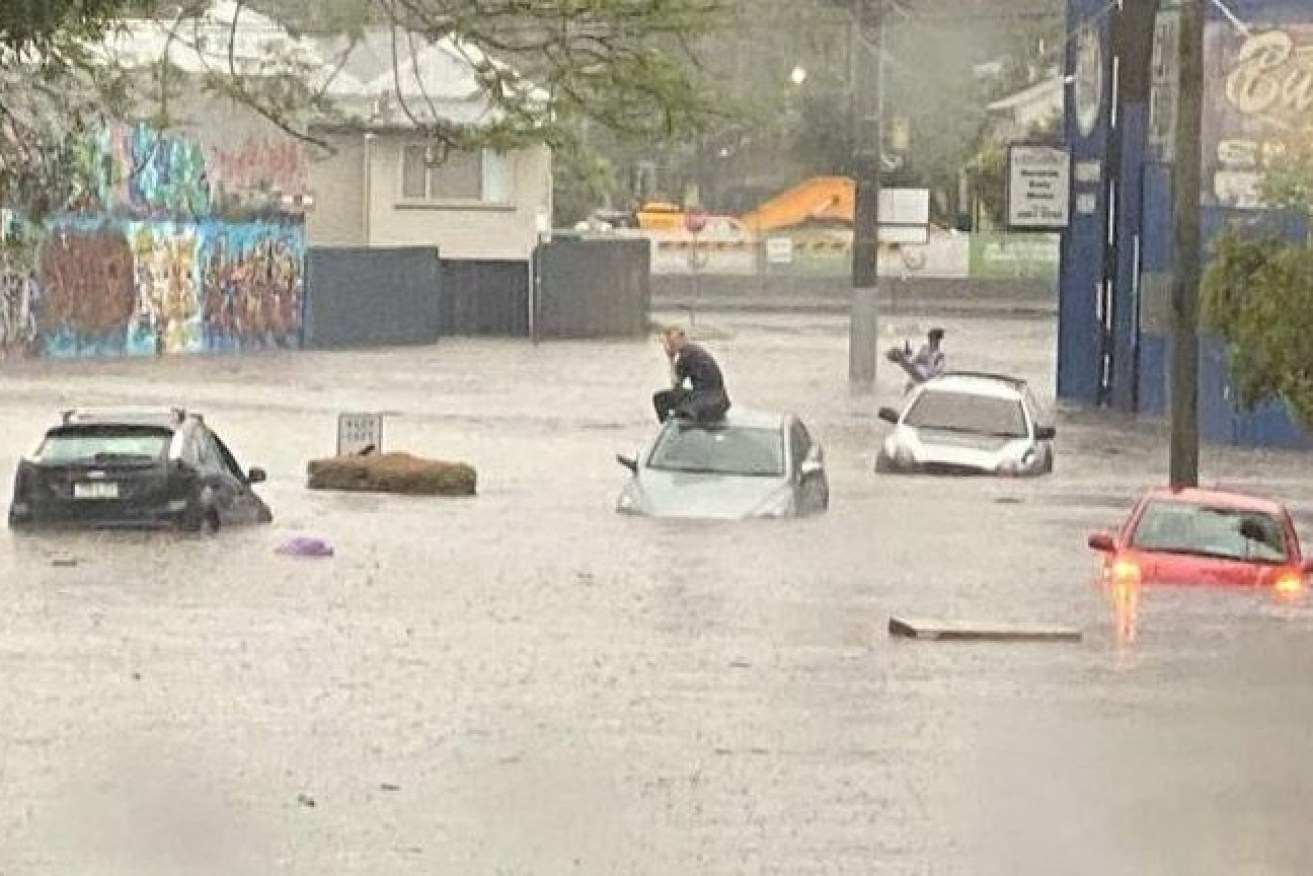Drowning in red tape: Councils call on Frydenberg to save flood warning system from disaster
Queensland’s frontline flood warning system has been described as being in an “alarming” state of disrepair, putting pressure on the Morrison Government to commit to fixing the network in next week’s federal budget.


A man on top of his car trapped in flash flooding last week in Longlands Street in East Brisbane. (Photo: Supplied)
Queensland has the largest flood warning infrastructure network in the country, although too many of the state’s 3000 river and rain gauges are not fit-for-purpose, outdated or no longer reliable.
That is the assessment of Local Government Association of Queensland chief executive Alison Smith, whose organisation has been advocating for the network’s upgrading since an audit of the system was conducted last year.
So far, she has received a commitment to share the cost of the ongoing operation from the Queensland Government, prompting her to thank Deputy Premier Steven Miles for securing “a vital first step in ensuring the safety of local communities”.
But the Queensland Government’s commitment comes with a catch – they’ll only provide their proportion of the funding if the Commonwealth also commits to investing in the upgrade.
Smith won’t know if her lobbying for a 50-50 funding arrangement has been successful until Treasurer Josh Frydenberg delivers the Federal Budget on March 29.
As well as lodging a submission for the critical upgrades to Frydenberg ahead of the Budget, Smith has repeatedly called on Emergency Management and National Recovery and Resilience Minister Bridget McKenzie to support her petition.
Smith wrote again to the Senator this month in the wake of the Queensland flooding disaster. Correspondence has also been sent to the Federal Opposition.
According to Smith, flooding events are “well and truly” Queensland’s most prevalent natural disaster, accounting for 66 per cent of the Queensland total economic cost, with cyclones a distant second at 25 per cent, ahead of hail damage and storms.
With the nation’s most significant recorded flood damage, and the highest flood risk, Smith said Queenslanders should feel reassured they had the largest flood warning infrastructure network in the country.
“However, too many of the early flood warning network’s 3000 gauges are not fit-for-purpose, with further gauges past their use-by date and no longer reliable,” she said.
The LGAQ last year collaborated with the Bureau of Meteorology and the Queensland Reconstruction Authority on an extensive scoping study to improve the reliability of the flood warning system.
It identified and recommended options for the design, performance, maintenance, ownership, governance and funding for a fit-for-purpose Queensland flood warning network.
As parts of the state are still left reeling by the recent deluge that inundated thousands of properties, Smith said the state of the network uncovered by investigators was nothing short of “alarming”.
“On top of up much-needed upgrades, the scoping study proposed 89 extra river height stations and a further 364 rainfall stations where the risk of flooding is most acute,” Smith said.
“Gaps in this network mean Queensland communities are not getting accurate, vital information as swiftly as they should.
“The network significantly relies on manual rain gauge measurement and recording and, as current weather events have demonstrated, people are unable to wade out into flood waters to manually take rain gauge readings to obtain critical information due to health and safety risks.
“This is the case across the state during extreme weather events.”
It is not known how significant response times would have improved during this year’s flood disaster had the network been working optimally.
The picture Smith describes is a ramshackle network of a bygone era, that is placing staff under stress due to its need for manual maintenance and its inferior quality.
“The network also requires a regular, manual maintenance program to ensure any damage caused to equipment during weather events is identified as early as possible and addressed,” she said.
“The Bureau of Meteorology is doing the best it can with the equipment it has to hand.
“Closing the gaps in this network will help protect property from rising flood waters and, above all, save lives.
“Every community in Queensland contributes to the national economy so every Queensland community deserves to be safe and liveable.
“Bringing the rain and river gauge network up to date, and securing its long-term operation and maintenance, is absolutely fundamental to that.”










